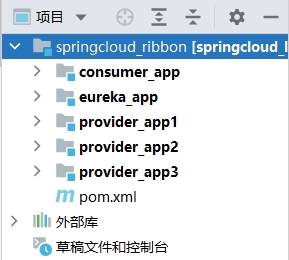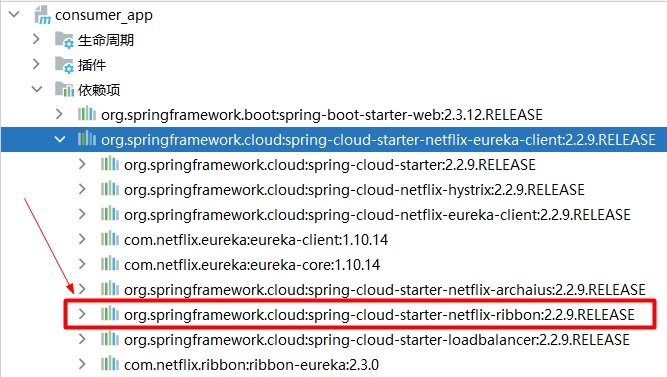SpringCloud 使用 Ribbon 实现客户端负载均衡
SpringCloud 在 2020.0.1 版本之前,服务的消费者在引入 spring-cloud-starter-netflix-eureka-client 的依赖后(该依赖内置了 Ribbon 依赖),就可以使用 Ribbon 客户端负载均衡了。Ribbon 支持 10 种客户端负载均衡策略,使用起来很方便。
本篇博客基于上篇博客的 Demo 进行简单改造,服务消费者调用服务提供者的接口,采用Ribbon 进行客户端负载均衡,总体过程非常简单。在本篇博客的最后会提供 Demo 源代码的下载。
一、搭建工程
与上一篇博客的 Demo 基本相同,采用 Maven 搭建 springcloud_ribbon 父工程,下面包含 5 个子工程:
- 1 个 Eureka 注册中心
- 1 个 Consumer 服务消费者
- 3 个 Provider 服务提供者
搭建后的效果如下图所示:

对于 springcloud_ribbon 父工程 pom 文件内容如下所示:
<?xml version="1.0" encoding="UTF-8"?>
<project xmlns="http://maven.apache.org/POM/4.0.0"
xmlns:xsi="http://www.w3.org/2001/XMLSchema-instance"
xsi:schemaLocation="http://maven.apache.org/POM/4.0.0
http://maven.apache.org/xsd/maven-4.0.0.xsd">
<modelVersion>4.0.0</modelVersion>
<groupId>com.jobs</groupId>
<artifactId>springcloud_ribbon</artifactId>
<packaging>pom</packaging>
<version>1.0-SNAPSHOT</version>
<modules>
<module>eureka_app</module>
<module>provider_app1</module>
<module>provider_app2</module>
<module>provider_app3</module>
<module>consumer_app</module>
</modules>
<properties>
<project.build.sourceEncoding>UTF-8</project.build.sourceEncoding>
<project.reporting.outputEncoding>UTF-8</project.reporting.outputEncoding>
<java.version>1.8</java.version>
</properties>
<!--spring boot-->
<parent>
<groupId>org.springframework.boot</groupId>
<artifactId>spring-boot-starter-parent</artifactId>
<version>2.3.12.RELEASE</version>
</parent>
<!--Spring Cloud-->
<dependencyManagement>
<dependencies>
<dependency>
<groupId>org.springframework.cloud</groupId>
<artifactId>spring-cloud-dependencies</artifactId>
<version>Hoxton.SR12</version>
<type>pom</type>
<scope>import</scope>
</dependency>
</dependencies>
</dependencyManagement>
</project>
注意:这里使用 SpringBoot 的版本是 2.3.12.RELEASE ,使用的 SpringCloud 版本是 Hoxton.SR12
有关【Eureka 注册中心】和【服务提供者】的搭建过程,这里就省略了,跟上篇博客一模一样。
二、服务消费者搭建
本篇博客的服务消费者搭建的结果如下所示:

在 pom 文件中引入 spring-cloud-starter-netflix-eureka-client 的依赖,如下所示:
<?xml version="1.0" encoding="UTF-8"?>
<project xmlns="http://maven.apache.org/POM/4.0.0"
xmlns:xsi="http://www.w3.org/2001/XMLSchema-instance"
xsi:schemaLocation="http://maven.apache.org/POM/4.0.0
http://maven.apache.org/xsd/maven-4.0.0.xsd">
<parent>
<artifactId>springcloud_ribbon</artifactId>
<groupId>com.jobs</groupId>
<version>1.0-SNAPSHOT</version>
</parent>
<modelVersion>4.0.0</modelVersion>
<artifactId>consumer_app</artifactId>
<dependencies>
<!--spring boot web-->
<dependency>
<groupId>org.springframework.boot</groupId>
<artifactId>spring-boot-starter-web</artifactId>
</dependency>
<!--eureka-client-->
<dependency>
<groupId>org.springframework.cloud</groupId>
<artifactId>spring-cloud-starter-netflix-eureka-client</artifactId>
</dependency>
</dependencies>
</project>
查看 spring-cloud-starter-netflix-eureka-client 下所包含的 jar 包结构,可以发现其包含了 ribbon 的 jar 包依赖。

下面列出 application.yml 的内容,跟上一篇博客完全一样。
server:
port: 8100
eureka:
instance:
# 配置主机名
hostname: consumer-service
# 显示 ip 地址,代替显示主机名
prefer-ip-address: true
# 所注册服务实例名称的显示形式
instance-id: ${eureka.instance.hostname}:${server.port}
# 每隔 3 秒发一次心跳包
lease-renewal-interval-in-seconds: 3
# 如果 15 秒没有发送心跳包,就让 eureka 把自己从服务列表中移除
lease-expiration-duration-in-seconds: 15
client:
service-url:
# 将当前 springboot 服务注册到 eureka 中
defaultZone: http://eureka-server:8761/eureka
# 是否将自己的路径注册到 eureka 上
register-with-eureka: true
# 是否需要从 eureka 中抓取路径
fetch-registry: true
# consumer 使用的 application 名称
spring:
application:
name: consumer-App
只需要在 RestTemplate 的 Bean 对象上增加 @LoadBalanced 注解,即可实现 ribbon 客户端负载均衡的默认策略:轮询。
package com.jobs.consumer.config;
import org.springframework.cloud.client.loadbalancer.LoadBalanced;
import org.springframework.context.annotation.Bean;
import org.springframework.context.annotation.Configuration;
import org.springframework.web.client.RestTemplate;
@Configuration
public class RestTemplateConfig {
@LoadBalanced
@Bean
public RestTemplate restTemplate() {
return new RestTemplate();
}
}
然后使用 RestTemplate 调用服务提供者的接口时,使用服务提供者的 application 名称,从注册中心获取服务提供者集群的所有服务地址,自动在本地通过负载均衡的算法,决定要调用那一个服务地址。
需要注意的是:服务提供者的名称最好从 Eureka 注册中心界面中复制,这么不容易出错。
下面列出服务消费者调用服务提供者接口的代码
package com.jobs.consumer.controller;
import org.springframework.beans.factory.annotation.Autowired;
import org.springframework.web.bind.annotation.PathVariable;
import org.springframework.web.bind.annotation.RequestMapping;
import org.springframework.web.bind.annotation.RestController;
import org.springframework.web.client.RestTemplate;
import java.util.Map;
@RequestMapping("/consumer")
@RestController
public class ConsumerController {
@Autowired
private RestTemplate restTemplate;
@RequestMapping("/getdata/{id}")
public Map GetData(@PathVariable("id") int id) {
//使用服务在 eureka 上注册的 application 名称代替 ip 和端口号
String url = "http://PROVIDER-APP/provider/getdata/" + id;
Map result = restTemplate.getForObject(url, Map.class);
return result;
}
}
注意:上面采用 PROVIDER-APP 代替了服务提供者的 ip 和 端口,PROVIDER-APP 是从注册中心界面中复制过来的。
到此为止,服务的消费者采用轮询的客户端负载均衡方式,调用服务提供者接口的代码示例,已经搭建完毕,可以进行测试验证。
三、使用其它负载均衡策略
只需要通过 2 个步骤即可实现:
首先需要定义一个配置类,提供一个方法用于将系统内置的负载均衡算法对象加载到 Spring 容器中。
package com.jobs.consumer.config;
import com.netflix.loadbalancer.IRule;
import com.netflix.loadbalancer.RandomRule;
import org.springframework.context.annotation.Bean;
import org.springframework.context.annotation.Configuration;
@Configuration
public class LoadBalanceRule {
@Bean
public IRule rule(){
/*
需要注意:SpringCloud 在 2010.0.1 版本之前,集成了 Ribbon。
在 2010.0.1 版本之后,使用 LoadBalance 替代了 Ribbon。
当前使用的 SpringCloud 版本为 Hoxton.SR12 ,可以使用 Ribbon。
Ribbon 提供了 10 种客户端负载均衡策略,
如果不配置的话,默认采用轮询策略
常用的有 7 种,如下所示:
随机 :RandomRule
轮询 :RoundRobinRule
最小并发:BestAvailableRule
可用性过滤:AvailabilityFilteringRule
最小响应时间:WeightedResponseTimeRule
失败后轮询重试:RetryRule
性能可用性:ZoneAvoidanceRule
*/
//此处采用的负载均衡策略为随机
return new RandomRule();
}
}
然后在服务消费者的 SpringBoot 启动类上,@RibbonClient 或 @RibbonClients 注解,针对不同的服务提供者,配置不同的客户端负载均衡策略。由于本 Demo 只有一个 PROVIDER-APP 服务提供者,因此使用 @RibbonClient 进行配置。
package com.jobs.consumer;
import com.jobs.consumer.config.LoadBalanceRule;
import org.springframework.boot.SpringApplication;
import org.springframework.boot.autoconfigure.SpringBootApplication;
import org.springframework.cloud.netflix.ribbon.RibbonClient;
/*
在这里可以通过 @RibbonClient 和 @RibbonClients 两个注解,
针对不同的服务提供者,配置不同的客户端负载均衡策略。
本 Demo 只有一个 PROVIDER-APP 服务提供者,因此只配置了一个服务,配置为随机策略。
如果针对具体的服务提供者,不配置负载均衡策略的话,默认采用轮询策略。
*/
@RibbonClient(name = "PROVIDER-APP",configuration = LoadBalanceRule.class)
@SpringBootApplication
public class ConsumerApp {
public static void main(String[] args) {
SpringApplication.run(ConsumerApp.class,args);
}
}
经过以上配置后,重启消费者程序后,再调用 PROVIDER-APP 所提供的接口时,采用的就是随机的客户端负载均衡策略。
OK,到此为止,有关 SpringCloud 使用 Ribbon 实现客户端负载均衡的实现方式,已经介绍完毕。
本篇博客的源代码下载地址为:https://files.cnblogs.com/files/blogs/699532/springcloud_ribbon.zip


 浙公网安备 33010602011771号
浙公网安备 33010602011771号